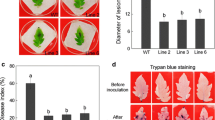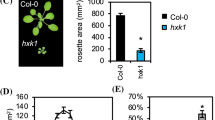Abstract
Previously, we reported that mitochondria-associated hexokinases are active in controlling programmed cell death in plants (Plant Cell 18, 2341-2355). Here, we investigated their role under abiotic- and biotic-stress conditions. Expression ofNbHxk1, aNicotiana benthamiana hexokinase gene, was stimulated by treatment with salicylic acid or methyl viologen (MV), and was also up-regulated by pathogen infection. In response to MV-induced oxidative stress, NbHxk1-silenced plants exhibited increased susceptibility, while the HXK1— and HXK2-overexpressingArabidopsis plants had enhanced tolerance. Moreover, those overexpressing plants showed greater resistance to the necrotrophic fungal pathogenAlternaria brassicicola. HXK-over-expression also mildly protected plants against the bacterial pathogenPseudomonas syringae pv.tomato DC3000, a response that was accompanied by increased H2O2 production and elevatedPR1 gene expression. These results demonstrate that higher levels of hexokinase confer improved resistance to MV-induced oxidative stress and pathogen infection.
Similar content being viewed by others
Literature cited
Alscher RG, Donahue JH, Cramer CL (1997) Reactive oxygen species and antioxidant: Relationships in green cells. Physiol Plant 100: 224–233
Alvarez ME, Pennell RI, Meijer PJ, Ishikawa A, Dixon RA, Lamb C (1998) Reactive oxygen intermediates mediate a systemic signal network in the establishment of plant immunity. Cell 20: 773–784
Azoulay-Zohar H, Israelson A, Abu-Hamad S, Shoshan-Barmatz V (2004) In self-defence: Hexokinase promotes voltage-dependent anion channel closure and prevents mitochondria-mediated apoptotic cell death. Biochem J 15: 347–355
Baker MA, Orlandi EW (1995) Active oxygen in plant pathogenesis. Annu Rev Phytopathol 33: 299–321
Balasubramanian R, Karve A, Kandasamy M, Meagher RB, Moore B (2007) A role for F-actin in hexokinase-mediated glucose signaling. Pant Physiol 145: 1423–1434
Balk J, Leaver CJ, McCabe PF (1999) Translocation of cytochrome c from the mitochondria to the cytosol occurs during heat-induced programmed cell death in cucumber plants. FEBS Lett 10: 151–154
Birnbaum MJ (2004) On the InterAktion between hexokinase and the mitochondrion. Dev Cell 7: 781–782
Bryson JM, Coy PE, Gottlob K, Hay N, Robey RB (2002) Increased hexokinase activity, of either ectopic or endogenous origin, protects renal epithelial cells against acute oxidant-induced cell death. J Biol Chem 29: 11392–11400
Downward J (2003) Metabolism meets death. Nature 21: 896–897
Frommer WB, Schulze WX, Lalonde S (2003) Hexokinase, Jack-of-all-trades. Science 11: 261–263
Giegé R, Heazlewood JL, Roessner-Tunali U, Millar AH, Fernie AR, Leaver CJ, Sweetlove LJ (2003) Enzymes of glycolysis are functionally associated with the mitochondrion inArabidopsis cells. Plant Cell 15: 2140–2151
Gottlob K, Majewski N, Kennedy S, Kandel E, Robey RB, Hay N (2001) Inhibition of early apoptotic events by Akt/PKB is dependent on the first committed step of glycolysis and mitochondrial hexokinase. Genes Dev 1: 1406–1418
Houot V, Etienne P, Petitot AS, Barbier S, Blein JP, Suty L (2001) Hydrogen peroxide induces programmed cell death features in cultured tobacco BY-2 cells, in a dose-dependent manner. J Exp Bot 5: 1721–1730
Jang JC, León P, Zhou L, Sheen J (1997) Hexokinase as a sugar sensor in higher plants. Plant Cell 9: 5–19
Kim M, Lim JH, Ahn CS, Park K, Kim GT, Kim WT, Pai HS (2006) Mitochondria-associated hexokinases play a role in the control of programmed cell death inNicotiana benthamiana. Plant Cell 18: 2341–2355
Majewski N, Nogueira V, Bhaskar P, Coy PE, Skeen JE, Gottlob K, Chandel NS, Thompson CB, Robey RB, Hay N (2004) Hexokinase-mitochondria interaction mediated by Akt is required to inhibit apoptosis in the presence or absence of Bax and Bak. Mol Cell 3: 819–830
McRoberts N, Lennard JH (1996) Pathogen behaviour and plant cell reactions in interactions betweenAlternaria species and leaves of host and nonhost plants. Plant Pathol 45: 742–752
Neill S, Desikan R, Hancock J (2002) Hydrogen peroxide signalling. Curr Opin Plant Biol 5: 388–395
Oh IS, Park AR, Bae MS, Kwon SJ, Kim YS, Lee JE, Kang NY, Lee S, Cheong H, Park OK (2005) Secretome analysis reveals anArabidopsis lipase involved in defense againstAlternaria brassicicola. Plant Cell 17: 2832–2847
Ordenes VR, Reyes FC, Wolff D, Orellana A (2002) A thapsigargin-sensitive Ca(2+) pump is present in the pea Golgi apparatus membrane. Plant Physiol 129: 1820–1828
Park JM, Paek KH (2006) Recognition and response in plant-pathogen interactions. J Plant Biol 50: 132–138
Pastorino JG, Shulga N, Hoek JB (2002) Mitochondrial binding of hexokinase II inhibits Bax-induced cytochrome c release and apoptosis. J Biol Chem 1: 7610–7618
Pitzschke A, Forzani C, Hirt H (2006) Reactive oxygen species signaling in plants. Antioxid Redox Signal 8: 1757–1764
Rolland F, Sheen J (2005) Sugar sensing and signalling networks in plants. Biochem Soc Trans 33: 269–271
Rolland F, Winderickx J, Thevelein JM (2001) Glucose-sensing mechanisms in eukaryotic cells. Trends Biochem Sci 26: 310–317
Sarowar S, Kim EN, Kim YJ, Ok SH, Kim KD, Hwang BK, Shin JS (2005) Overexpression of a pepper ascorbate peroxidase-like 1 gene in tobacco plants enhances tolerance to oxidative stress and pathogens. Plant Sci 169: 55–63
Stülke J, Hillen W (1999) Carbon catabolite repression in bacteria. Curr Opin Microbiol 2: 195–201
Suntres ZE (2002) Role of antioxidants in paraquat toxicity. Toxicology 30: 65–77
Thordal-Christensen H, Zhang Z, Wei YD, Collinge DB (1997) Subcellular localization of H2O2 in plants. H2O2 accumulation in papillae and hypersensitive response during the barley-powdery mildew interaction. Plant J 11: 1187–1194
Timbrell JA (1996) Introduction to Toxicology. Taylor and Francis, London
Timbrell JA (2000) Principles of Biochemical Toxicology. Taylor and Francis, London
Wilson JE (2003) Isozymes of mammalian hexokinase: Structure, subcellular localization and metabolic function. J Exp Biol 206: 2049–2057
Xiao W, Sheen J, Jang JC (2000) The role of hexokinase in plant sugar signal transduction and growth and development. Plant Mol Biol 44: 451–4
Author information
Authors and Affiliations
Corresponding author
Rights and permissions
About this article
Cite this article
Sarowar, S., Lee, J.Y., Ahn, E.R. et al. A role of hexokinases in plant resistance to oxidative stress and pathogen infection. J. Plant Biol. 51, 341–346 (2008). https://doi.org/10.1007/BF03036136
Received:
Accepted:
Issue Date:
DOI: https://doi.org/10.1007/BF03036136




